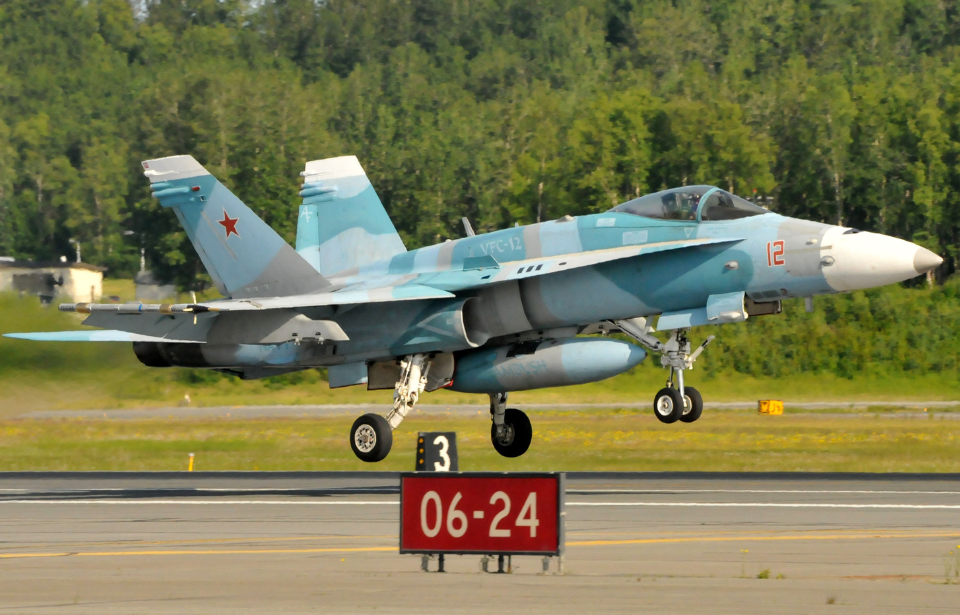On April 22, 1996, two US Navy McDonnell Douglas F/A-18 Hornets got into a mid-air collision during an exercise off the coast of Virginia. Both suffered physical damage, with one aircraft losing its nose section and canopy and the other losing a section of its port-side wing and parts of both vertical stabilizers.
Despite this, the two experienced pilots were able to fly their fighters back to Naval Air Station Oceana and land safely.
Lead up to the collision between the F/A-18 Hornets
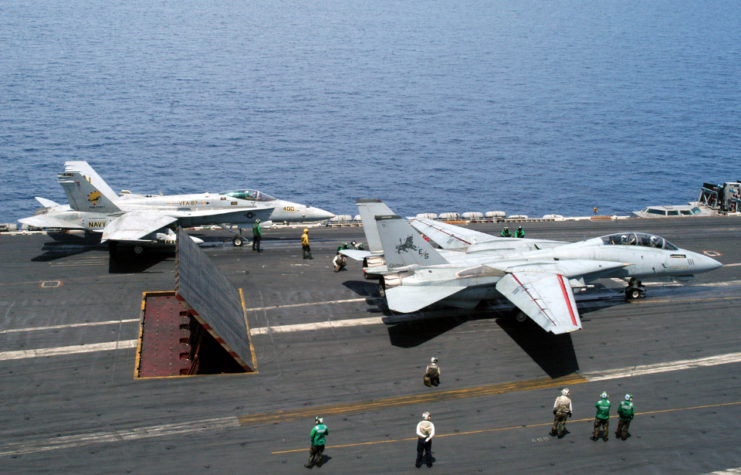
The collision between the F/A-18 Hornets occurred during a training exercise being conducted about 50 miles southeast of Naval Air Station Oceana, over the Atlantic Ocean. It was part of the Strike Fighter Advanced Readiness Program (SFARP), which saw F/A-18s from Fighter Squadron Composite 12 (VFC-12) play the role of aggressors, simulating Russian Mikoyan MiG-29s on a mission to attack Grumman F-14 Tomcats from Fighter Squadron 41 (VF-41).
VFC-12 were accompanied by Northrop Grumman EA-6B Prowlers, which masked the F-14s.
The exercise ultimately saw three F/A-18s up against two F-14s. The simulation had already run through twice, and the three aggressors got into formation for the third sortie of the day. As the F/A-18s approached, the F-14s simulated firing missiles toward the oncoming “MiG 29s,” successfully taking out two aircraft, piloted by Lt. Cmdr. Greg Stubbs and Greg Anderson.
Mid-air collision
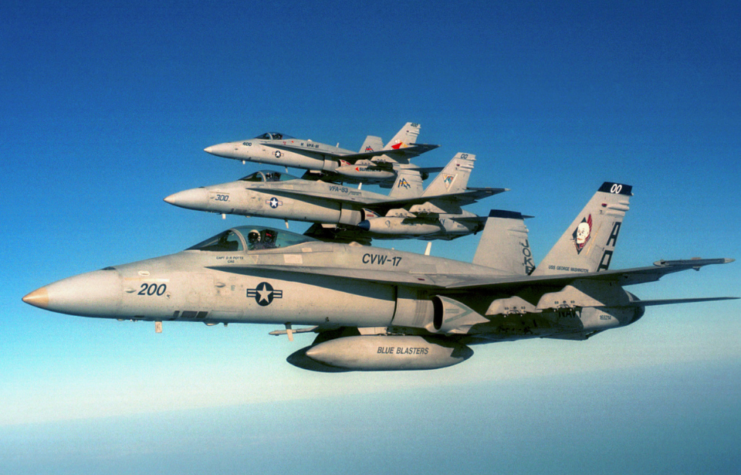
In the three aircraft formation, Anderson was on the left, with Stubbs in the middle and Lt. Cmdr. Cal Worthington on the right. As the F/A-18 Hornets made their way toward the F-14 Tomcats, two completed aileron rolls, showing they’d been “killed.”
It was during these rolls that the two F/A-18s collided. Stubbs later recounted in Rick Llinares and Chuck Lloyd’s Adversary: America’s Aggressor Fighter Squadrons, “I felt a sharp shudder in the airplane, and next thing I felt was the plane rolling left with the nose pointing down about eight degrees.”
The nose of Anderson’s F/A-18 ripped part of Stubbs’ left wing off, along with half of his vertical stabilizer. As a result of the mid-air collision, Anderson lost his aircraft’s nose, canopy and drop tank. One of his engines was also damaged. After some initial confusion on the radio, it was confirmed there’d been a collision and that both pilots were physically all right and had reasonable control of their aircraft.
Stubbs recalled looking down to the Atlantic below and thinking that, if he had to ditch, he’d rather do so closer to shore, as the water would likely still be cold. Able to control their aircraft, the pair turned toward the coast. The closest runway was at the Coast Guard station in Elizabeth City, but, despite being 40 miles closer than NAS Oceana, they decided that returning to base would be the best option.
Stubbs discovered the slowest speed he could fly was 200 knots. This raised two concerns. First, the arresting equipment that would help the aircraft stop had a speed limit of 175 knots. If he landed at a speed faster than that, it could result in the F/A-18’s tail hook being ripped off. On top of this, the speed rating for the aircraft’s tires was 182 knots, and the faster speeds could have resulted in the tires blowing upon landing.
Approach and landing
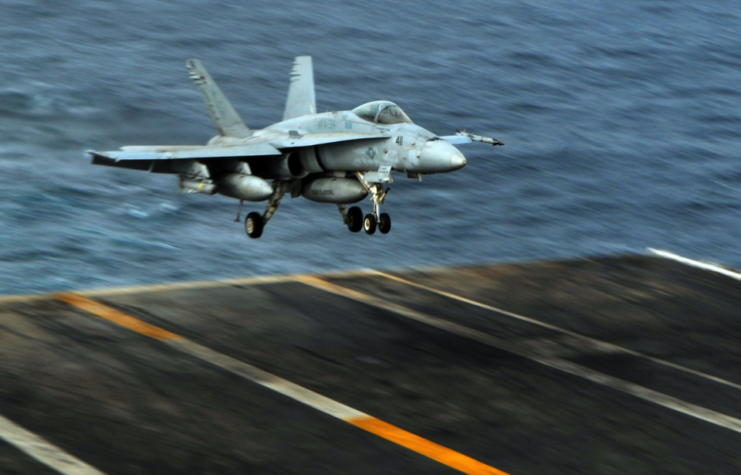
Stubbs didn’t really have a choice. As he approached NAS Oceana’s runway following the collision, two other F/A-18 Hornets that were returning from a different mission radioed if he wanted them to join him and keep an eye on things. He initially said no, but called Lt. Cmdr. Bertrand back.
The latter’s wingman, Lt. Cmdr. Bowman, recalled, “We were flying as a two ship and when LCDR Stubbs told LCDR Bertrand that he wanted help, the next thing I saw from my cockpit was the tailpipe of LCDR Bertrand’s F/A-18 with two burners going, moving at the speed of heat.”
Stubbs said having Bertrand join him confirmed just how much the pilots of their squadron cared for each other. He successfully lowered his landing gear and made his approach. At 200 knots, Stubbs touched down at the end of the runway and rolled until reaching the arrestor gear and coming to a stop. Upon stopping, the damage was clear, with fuel and hydraulic fluid leaking out of the left wing.
Anderson followed, landing his F/A-18 with wires flapping out of the nose, displaying the damage to his aircraft. The two naval aviators shook hands once they were out of their aircraft, both relieved and in disbelief at what they’d just accomplished.
Reaction to the F/A-18 Hornets’ mid-air collision
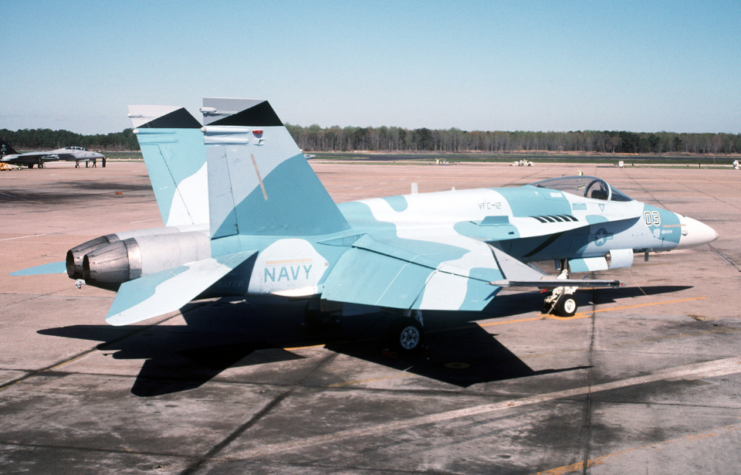
A story that begins with two aircraft colliding mid-air usually doesn’t typically end well. That being said, the April 22, 1996 mid-air collision between the F/A-18 Hornets saw the exact opposite be true. The pilots, both Persian Gulf veterans and members of the Naval Reserve, showed their training and skill in successfully returning their damaged aircraft to NAS Oceana.
Daryl Stephenson, a spokesman for McDonnell Douglas, later said the incident showcased the F/A-18’s “survivability.” However, he did admit the result was “pretty amazing.” Stubbs echoed this, saying, “It was a significant testament to the construction of the F/A-18 – that we were able to fly both aircraft after the damage they sustained.”
More from us: The Boeing B-17F Flying Fortress ‘Memphis Belle’ Flew 25 Combat Missions Over Europe
After an investigation, both Stubbs and Anderson were returned to flight status within two months’ time. The two F/A-18s were beyond repair and didn’t return to service.
